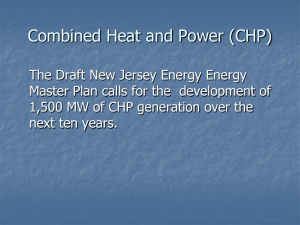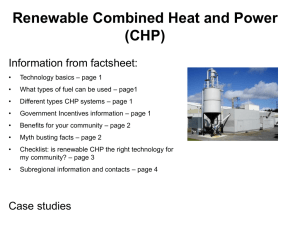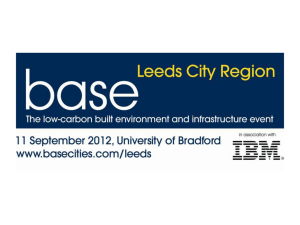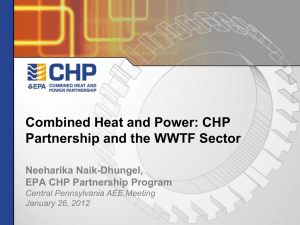Presentation
advertisement
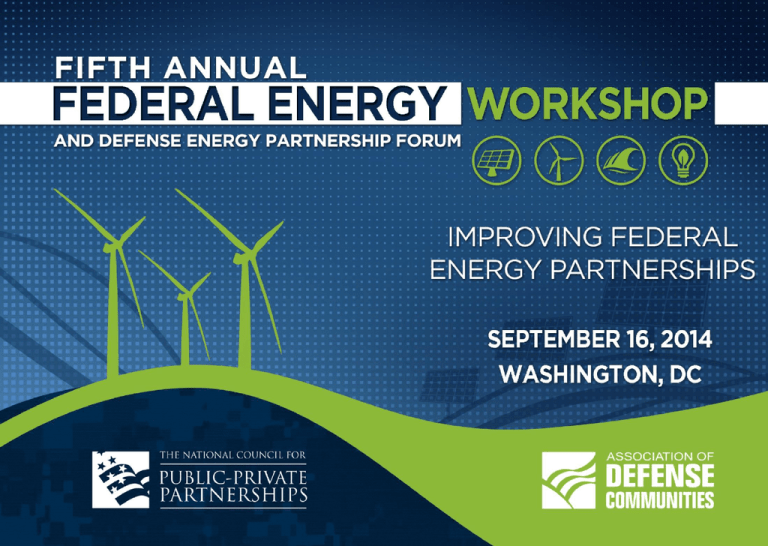
Bruce Hedman, Institute for Industrial Productivity September 16, 2014 FIFTH ANNUAL FEDERAL ENERGY WORKSHOP & DEFENSE ENERGY PARTNERSHIP FORUM | PAGE 2 About the Institute for Industrial Productivity The Institute for Industrial Productivity provides industry and governments with the best energy efficiency practices to reduce energy costs and prepare for a low carbon future. • Sharing best practices, including policy experience, and providing access to a network of international experts. • Developing original research, analysis and databases. • Bridging the gap between government policy and industry implementation. FIFTH ANNUAL FEDERAL ENERGY WORKSHOP & DEFENSE ENERGY PARTNERSHIP FORUM | PAGE 3 What Is Combined Heat and Power? • CHP is an integrated energy system that: • Is located at or near a factory, building or campus • Generates electrical and/or mechanical power • Recovers waste heat for heating, cooling or dehumidification • Can utilize a variety of technologies and fuels FIFTH ANNUAL FEDERAL ENERGY WORKSHOP & DEFENSE ENERGY PARTNERSHIP FORUM | PAGE 4 What Are the Benefits of CHP? • User - Reduced energy costs and improved power reliability • Environment – Reduced energy use and lower emissions (greenhouse gases, NOx, SOx, CO and PM) • Public Safety – Keep critical infrastructure operating and support the grid in times of emergency FIFTH ANNUAL FEDERAL ENERGY WORKSHOP & DEFENSE ENERGY PARTNERSHIP FORUM | PAGE 5 Efficiency Benefits of CHP Source: Oak Ridge National Laboratory FIFTH ANNUAL FEDERAL ENERGY WORKSHOP & DEFENSE ENERGY PARTNERSHIP FORUM | PAGE 6 CHP Value Proposition Category 10 MW CHP 10 MW PV 10 MW Wind 85% 22% 34% 74,446 MWh 19,272 MWh 29,784 MWh Annual Useful Heat 103,417 MWht None None Footprint Required 6,000 sq ft 1,740,000 sq ft 76,000 sq ft Capital Cost $20 million $45 million $24 million 316,218 MMBtu 198,563 MMBtu 306,871 MMBtu 42,506 Tons 17,824 Tons 27,546 Tons Annual Capacity Factor Annual Electricity Annual Energy Savings Annual CO2 Saving Source: CHP: A Clean Energy Solution; US DOE and EPA, 2012 Based on: 10 MW Gas Turbine CHP - 28% electric efficiency, 68% total efficiency Displaces National All Fossil Average Generation (eGRID 2010 ) 9,720 Btu/kWh, 1,745 lbs CO2/MWh, 6% T&D losses FIFTH ANNUAL FEDERAL ENERGY WORKSHOP & DEFENSE ENERGY PARTNERSHIP FORUM | PAGE 7 CHP Is an Important U.S. Energy Resource • 83.3 GW of installed CHP at over 4,220 industrial and commercial facilities • 86% of capacity in industrial applications • 70% of capacity is natural gas fired • Avoids more than 1.8 quadrillion Btus of fuel consumption annually Source: CHP Installation Database, March 2014 • Avoids 241 million metric tons of CO2 compared to separate production FIFTH ANNUAL FEDERAL ENERGY WORKSHOP & DEFENSE ENERGY PARTNERSHIP FORUM | PAGE 8 CHP is Used at the Point of Demand Source: CHP Installation Database FIFTH ANNUAL FEDERAL ENERGY WORKSHOP & DEFENSE ENERGY PARTNERSHIP FORUM | PAGE 9 The Potential for Additional CHP Development Is Significant Source: CHP: A Clean Energy Solution; US DOE and EPA, 2012 FIFTH ANNUAL FEDERAL ENERGY WORKSHOP & DEFENSE ENERGY PARTNERSHIP FORUM | PAGE 10 Federal Example – National Institute of Health • 75 buildings, 300 acres, 8 million ft2 laboratories, hospitals rooms, teaching facilities and offices • CHP system installed 2004 – 23 MW natural gas combustion turbine, – 180,000 lb/hr steam for space heating and cooling, and lab support • $62 million project – $16 million for energy efficiency and energy management systems upgrades • Annual energy savings: – 640 billion Btus – $4 million FIFTH ANNUAL FEDERAL ENERGY WORKSHOP & DEFENSE ENERGY PARTNERSHIP FORUM | PAGE 11 Federal Example – Jesse Brown VA Medical Center • Veterans Administration Hospital, Chicago, IL – 200 beds, 1,800 staff, 62,000 local vets • CHP system installed 2003 – 3.4 MW natural gas combustion turbine • 100% winter peak • 90% summer peak – 50,000 lb/hr steam for space heating and cooling, and sterilization • Enhanced Use Lease Project – ESG designed/built & maintains the Energy Center – Estimated savings to VA of $25 million over 25 years FIFTH ANNUAL FEDERAL ENERGY WORKSHOP & DEFENSE ENERGY PARTNERSHIP FORUM | PAGE 12 Federal Example – U.S. Coast Guard Shipyard • Curtis Bay (Baltimore), Maryland – – – – • Builds, repairs, renovates ships 112 acre site, 110 years old Houses other USCG tenants Annual budget of $88 million CHP System installed 2009 – Four 1 MW low NOx recip engines – Fueled by landfill gas (1.5 mile pipeline) – 2000 lb/hr 95 psi steam from each engine • DOE ESPC Contract – – – – Ameresco Project offsets 18,000 MWh and 71,000 Dthrm Energy security was an important driver Achieved entire DHS renewable energy goals through 2012 FIFTH ANNUAL FEDERAL ENERGY WORKSHOP & DEFENSE ENERGY PARTNERSHIP FORUM | PAGE 13 CHP Market Drivers • Changing natural gas outlook 8,000 • Growing recognition of • Opportunities created by: • Environmental 6,000 Capacity (MW) CHP benefits by state and federal policymakers 7,000 5,000 4,000 3,000 2,000 1,000 0 pressures • Growing interest in grid resiliency Source: ICF International FIFTH ANNUAL FEDERAL ENERGY WORKSHOP & DEFENSE ENERGY PARTNERSHIP FORUM | PAGE 14 CHP Market Drivers • Changing natural gas outlook 8,000 • Growing recognition of • Opportunities created by: • Environmental 6,000 Capacity (MW) CHP benefits by state and federal policymakers 7,000 5,000 4,000 3,000 2,000 1,000 0 pressures • Growing interest in grid resiliency Source: ICF International Over 3,000 MW announced/under construction FIFTH ANNUAL FEDERAL ENERGY WORKSHOP & DEFENSE ENERGY PARTNERSHIP FORUM | PAGE 15 Hurdles to CHP Deployment • Financial uncertainty • CHP cost and performance uncertainty • Regulatory uncertainty • Utility uncertainty FIFTH ANNUAL FEDERAL ENERGY WORKSHOP & DEFENSE ENERGY PARTNERSHIP FORUM | PAGE 16


